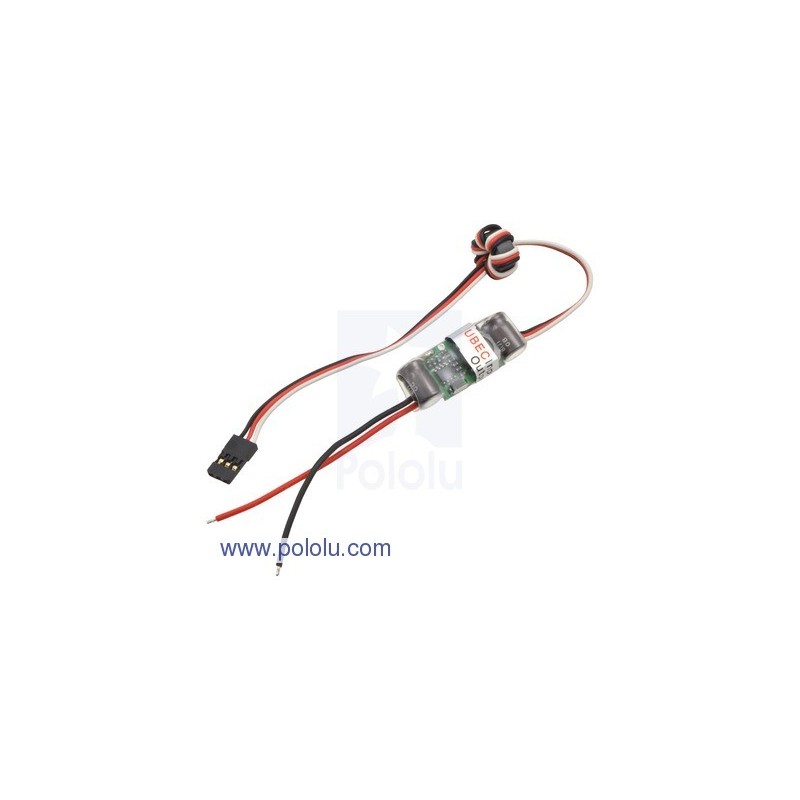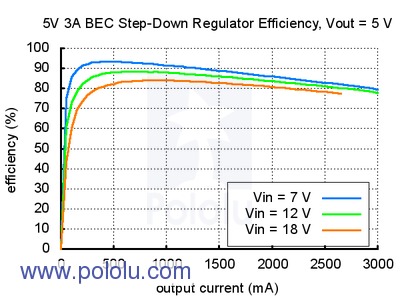- Out-of-Stock

This switching step-down (or buck) voltage regulator takes an input voltage of up to 23 V and reduces it to 5 V with a maximum output current of 3 A. It has 22-AWG input leads with stripped and tinned terminations and a 3-pin “JR”-style servo connector on the output lead.
This type of buck (step-down) voltage regulator is commonly used in the RC hobby industry, where it is called a “Battery Elimination Circuit” (BEC). It can convert a higher voltage, such as from a motor battery, to a lower 5 V level for powering devices like RC receivers and servos, removing the need for a separate battery. This switching regulator takes an input voltage between 5 and 23 V and reduces it to 5 V, providing up to 3 A of output current. However, the maximum achievable output current of the regulator depends on many factors, including the ambient temperature, air flow, heat sinking, and the input voltage.
Two 7 cm 22-AWG wires with stripped, tinned terminations are attached to the board as input leads. The output lead is a 15 cm 3-wire servo cable with a “JR” style connector on the end, although the white signal line is not used by the regulator. It includes a ferrite bead to reduce switching noise from the regulator. The cable has a female connector that fits nicely with 0.1" male headers, but these connectors are often referred to as “male” in the RC hobby industry. The connector on the output end is the same as what is found on most servos:
 |
The regulator’s output current is rated at 3 A continuous. However, over-temperature protection can kick in at lower output currents. Therefore, the maximum achievable output current of the regulator depends on many factors, including the ambient temperature, air flow, heat sinking, and the input voltage. In our tests at room temperature, a continuous output current of 3 A was available across nearly the entire input voltage range, although the regulator began to overheat before reaching 3 A at higher input voltages. These continuous current characteristics are limited by thermal dissipation; the regulator can output higher currents for several seconds or even tens of seconds, depending on how low the current is during the off-peak periods. Higher continuous output current can be achieved by reducing the input voltage or by cooling the board by adding a heat sink or a fan.
The efficiency of a voltage regulator, defined as (Power out)/(Power in), is an important measure of its performance, especially when battery life or heat are concerns. As shown in the graph below, this switching regulator typically has an efficiency of 80 to 90%. For example, when regulating 12 V to 5 V with an output current of 1.5 A, the efficiency is above 85%. Since the output power is (Output current)×(Vout) = 1.5 A × 5 V = 7.5 W, the input power will be a bit under 9 W, with about 1.2 W of heat dissipated in the regulator. The input current can then be calculated as 9 W/12 V = 0.75 A. This is far better than a linear voltage regulator, which would require an input current of 1.5 A and 18 W, wasting 10.5 W instead of the 1.2 W lost in this switching regulator.
 |
 |
Pololu Step-Down Voltage Regulator D15V35F5S3 |
 |
0.1" (2.54mm) Crimp Connector Housing: 1x2-Pin 25-Pack |
 |
0.1" (2.54mm) Crimp Connector Housing: 1x3-Pin 25-Pack |
Manufacturer BTC Korporacja sp. z o. o. Lwowska 5 05-120 Legionowo Poland sprzedaz@kamami.pl 22 767 36 20
Responsible person BTC Korporacja sp. z o. o. Lwowska 5 05-120 Legionowo Poland sprzedaz@kamami.pl 22 767 36 20
Printed circuit board and programmed circuit for microprocessor-based sound switch. AVT1835 A +
No product available!
Laser distance sensor with a measuring range of up to 2 m, based on the ToF measurement technique. Communication with the module takes place via the I2C interface. Waveshare VL53L0X Distance Sensor
No product available!
No product available!
No product available!
Hanna Mościcka-Grzesiak
No product available!
No product available!
No product available!
No product available!
No product available!
No product available!
A tachometer is a device designed to measure the rotational speed of various parts in engines and other mechanisms. It calculates revolutions per minute (RPM). The tachometer also measures and monitors load limits, in order to decrease or increase RPM so that the engine or mechanism runs within its optimal parameters. UGears 70153
No product available!
Graphic LCD 128x64, 75x52.8mm, FFSTN negative (white), KS108 controller, high contrast
No product available!
No product available!
No product available!
No product available!
MULTIODORNIK ELF-VLF - THE LAYOUT OF AUDIO AUDIO OPTOISOLATION - PRINTED PLATE
No product available!

